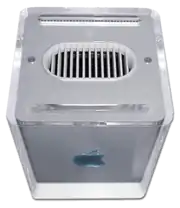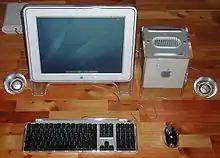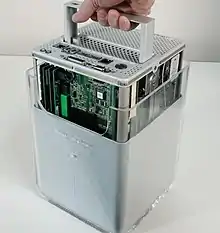Power Mac G4 Cube
The Power Mac G4 Cube is a small form factor Macintosh personal computer from Apple Computer, Inc., sold between 2000 and 2001. Designed by Jonathan Ive, the Cube was Apple's attempt to miniaturize a powerful desktop computer into a cube less than 8 inches (20 cm) to a side. Apple's designers pioneered new technologies and production to create the product, which Apple aimed at consumers in between the consumer iMac G3 and the professional Power Mac G4.
 A Power Mac G4 Cube | |
| Developer | Apple Computer, Inc. |
|---|---|
| Product family | Power Mac |
| Type | Desktop computer |
| Release date | July 19, 2000 |
| Introductory price | US$1,799 |
| Discontinued | July 3, 2001 |
| Dimensions | Height: 9.8 inches (25 cm) Width: 7.7 inches (20 cm) Depth: 7.7 inches (20 cm) |
| Mass | 14 lb (6.4 kg) |
| Related articles | Power Mac G4 |
Despite winning awards and plaudits for its design, the Cube was an immediate commercial failure. Production was suspended within a year of its announcement, making it a rare failure for the company under returning CEO Steve Jobs. Despite its lack of success with consumers, the Cube influenced the design of future Apple products from the iPod to the Mac mini. The New York Museum of Modern Art holds a G4 Cube, along with its distinctive Harman Kardon transparent speakers, as part of its collection.
Overview

The G4 Cube is a small cubic computer, suspended in a 7.7×7.7×9.8 in (20×20×25 cm) acrylic glass enclosure. The transparent plastic gives the impression the computer is floating.[2] The enclosure houses the computer's vital functions, including a slot-loading optical disc drive. The Cube requires a separate monitor with either an ADC or a VGA connection.[3] The machine has no fan to move air, and thus heat, through the case. Instead, it is passively cooled, with heat dissipated via a grille at the top of the case.[4] The base model shipped with a 450 MHz G4 processor, 64MB of RAM, 20GB hard drive, and an ATI Rage 128 Pro video card.[3] A higher-end model was available only through Apple's online store.[5]
To fit the components of a personal computer in the size of the case, the Cube does not feature expansion slots. The Cube does have a video card in a standard AGP slot, but could not fit a full-length card.[1] The power supply was located externally to save space, and the Cube features no input or outputs for audio on the machine itself. Instead, the Cube shipped with round Harman Kardon speakers and digital amplifier, attached to the computer via Universal Serial Bus (USB).[4] Despite its size, the Cube still fits three RAM slots, two FireWire 400 ports and two USB 1.1 ports for connecting peripherals in its frame. The computer's I/O and power cable are located on the underside of the machine. Access to the machine's innards is accomplished by inverting the unit and using a pop-out handle to slide the internals out of the shell.[5]
Development

The Cube was an important product to Apple,[6] and especially to Jobs, who said the idea for the product came from his own desires as a computer user. "I wanted the [flat-panel] Cinema display but I don't need the features of the PowerMac," he told Newsweek. Jobs minimalist aesthetic influenced the core components of the design, from the lack of a mechanical power button, to the trayless optical drive and quiet fanless operation.[7] The design team at Apple, lead by Jonathan Ive, attempted to fit the power of a desktop in a much smaller form factor; Ive saw traditional desktop tower computers as lazy, designed around what was easiest for engineers.[2] The Cube represented a shift in Apple, as the designers held increasing sway over product design.[2] The New York Times called the Cube "pure [...] industrial design" harkening to Bauhaus concepts.[8]
The Cube represented an effort to simplify the computer to its barest essentials, while leaving the interior easy to access.[2] As the G4 Cube has no fan, the design started with the heat sink.[1] The "magic" power button that turned on with a wave or touch was accomplished via the use of capacitive sensing.[2] The effort spent developing the Cube would pioneer new uses and processes for materials at Apple that would benefit later products.[2] Due to the technology included in the G4 Cube, Apple's engineers had a tough time keeping the total cost low. Advertising director Ken Segall recalled that Jobs learned of the product's price shortly before an ad agency meeting, and was left "visibly shaken" by the news, realizing that the high price might spell the product's failure.[9]
Release and reception
The G4 Cube was announced at Macworld Expo on July 19, 2000, as an end-of-show "one more thing". Jobs touted it as combining the power of the Power Mac G4 with a sleek design and miniaturization Apple learned from producing the iMac. Alongside the G4 Cube, Apple introduced a new mouse, keyboard, and displays to complement the machine.[10]
Rumors of a cube-shaped Apple computer had leaked out weeks in advance, and some sites had posted purported pictures. The machine's size and looks were immediately divisive, which Macworld editor Andrew Gore took as an indication that Apple had succeeded in a cutting-edge product.[4] The design was a point of praise, as well as jokes—the computer was compared to a Borg cube, toasters, or a box of Kleenex.[1] Others compared it to the NeXT Cube.[11] Ive and the design team were so amused by the comparison to a tissue box that they used spare Cube shells for that purpose in their studio.[2]
Reviews were generally positive. Peter H. Lewis, writing for The New York Times, called the computer the most attractive on the market, and that combined with Apple's displays and peripherals "[they] create a stunning array of desk sculpture."[12] PC Magazine Australia said that after changing the look of computers with the iMac, the G4 Cube had raised the bar for competitors even further.[13] Gore called the Cube a work of art that felt more like sculpture than a piece of technology, but noted that one had to live with compromises made in the service of art.[14]
Critics noted that in order to get easy access to plug and unplug peripherals via the I/O ports, users would have to tip the entire machine—risking accidental sleep activation or dropping the slippery plastic computer entirely.[5][15] Macworld found the touch-sensitive power button too sensitive and that they accidentally activated sleep mode regularly, and reported that the stock 5400-rpm hard drive and 64MB of RAM on the base model slowed the system considerably.[16][14]
The Cube won several international design awards on release,[17] as well as PC Magazine's best desktop computer for its Technical Innovation Awards.[18] The G4 Cube and its peripherals were acquired and showcased by the The Museum of Modern Art alongside other Apple products.[19]
Sales
The introduction of the Cube did not fit with Jobs' four-quadrant product matrix he had introduced since his return to Apple, leaving it without a clear niche in Apple's lineup.[20] It was as expensive as a similarly-equipped Power Mac, but did not feature extra room for more storage or PCI slots. It was likewise much more expensive than a specced-up consumer iMac.[3] Jobs said that he believed that creative professionals and designers would want one, and that the product was so great that it would inform buying patterns.[20]
Sales for the G4 Cube were much lower than expected. Apple had eleven profitable quarters before the Cube's announcement after being on the brink of bankruptcy,[7] but Apple's end-of-year financials for 2000 missed predicted revenues by $180 million.[21] Part of the drop in profit was attributed to the Cube, which sold only a third as many units as Apple had expected, creating a $90 million shortfall in their revenue targets. The Cube counted for just 29,000 of the Macs Apple shipped in the quarter, compared to 308,000 iMacs. Retailers were awash in excess product, leaving Apple with a large amount of unsold inventory heading into 2001 they expected to last until March. The computer appealed to high-end customers who wanted a small and sleek design, but Jobs admitted that audience was smaller than expected.[21][22] In February 2001, Apple lowered the price on the 500 MHz model and added new memory, hard drive, and graphics options.[23] These updates made little difference, and sales continued to decline. The G4 Cube sold just 12,000 units in the first quarter of 2001,[24] representing just 1.6% of the company's total computer sales.[25]
In addition to the product's high price, the G4 Cube suffered from other issues. Early buyers noticed cracks caused by the injection-molded plastic process, and the idea of a design-focused product having aesthetic flaws turned into negative public relations story for Apple, as well as turning off potential buyers for whom the aesthetics were its main appeal.[15][24][2] The Cube's radical departure from a conventional personal computer alienated potential buyers, and exacerbated Apple's struggles in the market competing with the performance of Windows PCs. Macworld wrote that consumers treated the Cube as "an underpowered, over-expensive toy or—in contrast with the anthropomorphized everyman's iMac—an emotionally inaccessible, ultra-geometric gray box suspended in an untouchable glass prison."[24] The lack of internal expansion and reliance on less-common USB and FireWire peripherals also hurt the computer's chances of success.[26]
Despite Jobs' clear love of the computer,[20] he was quick to axe the underperforming product. On July 3, 2001, an Apple press release made the unusual statement that the computer – rather than being canceled or discontinued – was having its production "suspended indefinitely" due to low demand. Apple did not rule out an upgraded Cube model in the future, but considered it unlikely.[25] Jobs' ability to quickly move on the mistake left the G4 Cube a "blip" in Apple's history, according to Segal—a quickly-forgotten failure amidst other successful innovations.[9]
Legacy
Though Apple CEO Tim Cook called the G4 Cube "a spectacular failure"[6] and the product sold only 150,000 units before being discontinued, the Cube became highly popular with a small but enthusiastic group of fans.[27] Macworld's Benj Edwards wrote that the G4 Cube was simply ahead of its time, with its appeal to a dedicated group of fans years after it was discontinued a testament to its visionary design.[26] After its discontinuation the product fetched high prices from resellers, and a cottage industry developed selling upgrades and modifications to make the machine run faster or cooler.[27] John Gruber wrote 20 years after its introduction that the Cube was a "worthy failure [...] Powerful computers needed to get smaller, quieter, and more attractive. The Cube pushed the state of the art forward."[28]
While the G4 Cube failed commercially, it influenced future Apple products. The efforts at miniaturizing computer components would pay off in future computers like the flatscreen iMac G4.[2][29] The Mac mini fit an entire computer in a shell one-fifth the size of the Cube and retained some of the G4 Cube's design philosophies. In comparison to the high price of the Cube, the Mini retailed for $499 and became a successful product that remains part of Apple's lineup.[26][30] The translucent cube shape would return with the design for Apple's flagship Apple Store on Fifth Avenue in New York City.[31] Capacitive touch would reappear in the iPod and iPhone lines,[2] while the Cube's vertical thermal design and lattice grille pattern were echoed by the 2013 and 2019 versions of the Mac Pro.[32][33]
CNET called the machine "an iconic example of millennium-era design".[34] Its unconventional and futuristic appearance earned it a spot as a prop in several films and television shows, including Absolutely Fabulous, The Drew Carey Show, and 24.[17] Sixteen Cubes were also used to power the displays of the computer consoles in Star Trek: Enterprise.[35]
Specifications
| Model identifier | PowerMac5,1 |
|---|---|
| Model number | M7642LL/A (450 MHz), Configure-to-order-only (500 MHz) |
| Processor | 450 MHz or 500 MHz PowerPC G4 with 1 MB L2 cache |
| Memory | 128 MB up to 1.5 GB of PC100 SDRAM |
| Graphics | ATI Rage 128 Pro with 16 MB SDRAM, Nvidia GeForce2 MX with 32 MB SDRAM, or ATI Radeon with 32 MB DDR SDRAM |
| Hard drive | 20 GB, 40 GB, or 60 GB Ultra ATA/66 Hard Drive |
| Optical drive | CD-RW or DVD-ROM |
| Connectivity | Optional AirPort 802.11b 10/100 BASE-T Ethernet 56k V.90 modem |
| Peripherals | 2 USB 1.1 2 FireWire 400 |
| Video out | VGA and ADC |
| Maximum operating system | Mac OS X 10.4.11 "Tiger" and Mac OS 9.2.2 |
| Dimensions | 9.8×7.7×7.7 inches (25×20×20 cm) |
| Weight | 14 pounds (6.4 kg) |
References
- Staff (October 2001). "Resistance is Futile". MacAddict. No. 50. Future US. pp. 30–31. ISSN 1088-548X.
- Kahney, Leander (2014). Jony Ive: The Genius Behind Apple's Greatest Products. Penguin. pp. 155–158. ISBN 9781591847069.
- Siracusa, John (July 28, 2000). "MacWorld Expo NY 2000". Ars Technica. Condé Nast Publications. pp. 1–8. Retrieved October 8, 2020.
- Gore, Andrew (October 2000). "Your Assimilation Starts Here; The Cube". Macworld. IDG. pp. 11, 26, 28. ISSN 0741-8647.
- Grumet, Tobey (November 2000). "Technology; Apple³". Popular Mechanics. Vol. 177 no. 11. Hearst Magazines. pp. 80–81. ISSN 0032-4558.
- Cook, Tim (October 11, 2017). "In Conversation with Apple CEO Tim Cook – The Oxford Foundry Launch". Saïd Business School, University of Oxford. Event occurs at 1:03:21–1:04:20. Retrieved October 9, 2020 – via Youtube.
- Levy, Steven (July 30, 2000). "Thinking Inside The Box". Newsweek. The Washington Post Company. Retrieved October 7, 2020.
- Muschamp, Herbert (October 15, 2000). "ART/ARCHITECTURE; A Happy, Scary New Day for Design". The New York Times. Retrieved November 10, 2020.
- Segall, Ken (2012). Insanely Simple: The Obsession That Drives Apple's Success. Penguin UK. ISBN 9780670921201.
- "Apple Introduces Revolutionary G4 Cube". Apple, Inc. July 19, 2000. Retrieved August 9, 2020.
- Linzmayer, Owen (2004). Apple Confidential 2.0: The Definitive History of the World's Most Colorful Company. No Starch Press. p. 209. ISBN 9781593270100.
- Lewis, Peter (August 31, 2000). "State of the Art; Classic Beauty, Cubed". The New York Times. Retrieved November 6, 2020.
- Staff (December 19, 2020). "Apple PowerMac G4 Cube". PCMag Australia. Retrieved November 10, 2020.
- Gore, Andrew (July 31, 2020). "Capsule Review: Power Mac G4 Cube". Macworld. IDG. Retrieved November 10, 2020.
- Siracusa, John (October 1, 2000). "G4 Cube & Cinema Display". Ars Technica. Condé Nast Publications. Retrieved November 2, 2020.
- Loyola, Gil (August 22, 2020). "Lab report: Cube scores low compared to other Power Mac G4s". CNN. Retrieved November 10, 2020.
- O'Grady, Jason (2009). Apple Inc. ABC-Clio. pp. 103–104. ISBN 9780313362446.
- MacWorld Staff (December 21, 2000). "Cube scoops kudos from PC Magazine". CNN. Retrieved November 6, 2020.
- Patton, Phil (August 16, 2001). "NEWS WATCH: DESIGN; The Apple Cube Entered The Museum as It Exited Stores". The New York Times. p. G3. Retrieved November 6, 2020.
- Levy, Steven (July 24, 2020). "20 Years Ago, Steve Jobs Built the 'Coolest Computer Ever.' It Bombed". Wired. Condé Nast Publications. Retrieved October 7, 2020.
- Sammis, Ian (January 2001). "Get Info; Too Many Cubes". MacAddict. No. 53. Future US. p. 14. ISSN 1088-548X.
- "Apple: We expected to sell 3 times more Cubes". CNET. RedVenture. January 2, 2002. Retrieved November 6, 2020.
- Gibson, Brad (February 7, 2001). "Apple lowers price of G4 Cube". CNN. CNN Worldwide. Retrieved November 5, 2020.
- Edwards, Benj (August 12, 2010). "The Cube at 10: Why Apple's eye-catching desktop flopped". Macworld. IDG. Retrieved November 5, 2020.
- Gaither, Chris (July 4, 2001). "Apple Will Halt Production Of Its Cube-Shaped Computer". The New York Times. p. C6. Retrieved November 6, 2020.
- Edwards, Benj (August 12, 2010). "Apple's Cube was ahead of its time". MacUser. IDG. Retrieved November 6, 2020.
- Kahney, Leander (July 28, 2003). "Apple Cube: Alive and Selling". Wired. Condé Nast Publications. Retrieved October 12, 2020.
- Gruber, John (July 27, 2020). "Steven Levy on Steve Jobs and the G4 Cube". Daring Fireball. Retrieved October 9, 2020.
- Pogue, David (January 10, 2002). "State of the Art; For Apple, To Be Flat Is a Virtue". The New York Times. The New York Times Company. p. G1. Retrieved October 14, 2020.
- Snell, Jason (September 20, 2020). "20 Macs for 2020: #14 – Mac mini". Six Colors. Retrieved October 7, 2020.
- Lidwell, William; Manacsa, Gerry (2011). Deconstructing Product Design: Exploring the Form, Function, Usability, Sustainability, and Commercial Success of 100 Amazing Products. Rockport Publishers. pp. 152–153. ISBN 9781592537396.
- Cunningham, Andrew (June 10, 2013). "At long last! Apple announces new Mac Pro with cylindrical design". Ars Technica. Condé Nast Publications. Retrieved October 14, 2020.
- Hackett, Steven (June 18, 2019). "On the Mac Pro, the G4 Cube and Their Shared Vent Design". 512 Pixels. Retrieved October 14, 2020.
- Brown, Rich (October 7, 2011). "Steve Jobs' Mac design legacy (photos)". CNET. Red Ventures. Retrieved November 6, 2020.
- Haslam, Oliver (December 30, 2019). "Did you know 'Star Trek: Enterprise' used Mac G4 Cubes during production? You do now". iMore. Retrieved November 6, 2020.
- "Power Mac G4 (Cube) - Technical Specification". Apple, Inc. April 6, 2016. Retrieved November 5, 2020.
External links
- Apple – Power Mac G4 Cube at the Wayback Machine (archived December 16, 2000)
- Video of Jobs launching G4 Cube at Macworld 2000